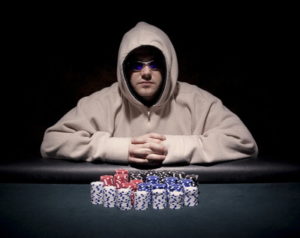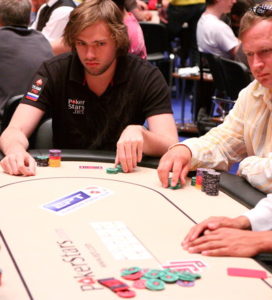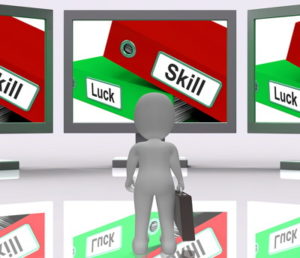 Part of the reason poker is such a popular game with so many people is that you can win even when you’ve got the worst hand on the table. The fact that no one knows what anyone else’s cards are, with only the ones that have been placed on the table being known to everyone, means that you could tell everyone you’ve got four aces and they can’t know for certain whether you’re lying or not.
Part of the reason poker is such a popular game with so many people is that you can win even when you’ve got the worst hand on the table. The fact that no one knows what anyone else’s cards are, with only the ones that have been placed on the table being known to everyone, means that you could tell everyone you’ve got four aces and they can’t know for certain whether you’re lying or not.
The art of bluffing in poker is a skill that goes beyond the mere act of deception. It is a strategic manoeuvre that involves understanding the psychology of the game and using it to manipulate opponents’ perceptions and actions.
Bluffing is an essential tool in a poker player’s arsenal, but its implications extend far beyond the poker table. By analysing the psychology behind bluffing and exploring its applications in other areas of life, we can gain valuable insights into human behaviour and decision-making.
At its core, bluffing in poker involves representing a stronger hand than the one that we actually possess. It requires a keen understanding of human psychology, particularly the tendencies of individuals to make assumptions and rely on patterns; something that can be useful in many different circumstances.
What Is Bluffing?
 Before we look too deeply into the art of bluffing, it is important to outline what it is that we’re actually talking about. In essence, bluffing in poker refers to the act of representing a stronger hand than what a player actually holds.
Before we look too deeply into the art of bluffing, it is important to outline what it is that we’re actually talking about. In essence, bluffing in poker refers to the act of representing a stronger hand than what a player actually holds.
It is a strategic move that is used to deceive opponents and make them believe that the hand that they’re up against is better than the one that they have. Bluffing is a fundamental aspect of poker and is employed to win pots without having the best hand or to extract more chips from opponents who hold weaker hands in order to take their money.
When a player decides to bluff, they are essentially attempting to convince their opponents that they have a hand that is superior to what their actual cards say. This is done through a combination of betting actions, body language and verbal cues.
The goal is to create doubt and uncertainty in the minds of opponents, ultimately leading them to fold their hands and concede the pot. It is typically employed in situations where a player believes their opponents have weak hands or when the community cards on the table present the possibility of a strong hand that they can pretend that they’ve got.
Why It Is A Key Poker Skill
 Skilled poker players use the ability to bluff to their advantage by carefully observing their opponents, assessing their behaviour and trying to exploit any weaknesses. The first aspect of bluffing is creating a credible story.
Skilled poker players use the ability to bluff to their advantage by carefully observing their opponents, assessing their behaviour and trying to exploit any weaknesses. The first aspect of bluffing is creating a credible story.
Players must present consistent and convincing behaviour that aligns with the image of having a strong hand. This involves controlling body language, maintaining a steady demeanour and using verbal cues strategically. By presenting a confident and composed facade, players aim to persuade opponents into believing the bluff.
It isn’t just about getting your opponent to think that you’ve got a better hand than them, but it’s also about getting them to make sub-optimal decisions based on that false information. Another critical component of bluffing is timing.
Knowing when to bluff requires astute observation of the game’s dynamics and the specific tendencies of opponents. It involves understanding the potential risks and rewards associated with each bluffing opportunity. Effective bluffing often occurs in situations where opponents are more likely to fold, such as when the community cards create the possibility of a strong hand.
It Is A Risk-Reward Strategy
 The best poker players will use a bluff when players have shown weakness in their betting patterns. Bluffing in poker is not without its risks. Players must carefully balance their bluffing frequency to avoid being predictable and exploitable.
The best poker players will use a bluff when players have shown weakness in their betting patterns. Bluffing in poker is not without its risks. Players must carefully balance their bluffing frequency to avoid being predictable and exploitable.
Over-bluffing can lead to losing credibility and being called out by opponents, while under-bluffing can result in missed opportunities to maximise your winnings. A successful bluff requires a delicate balance of risk-taking, calculation and adaptability. Getting that risk-reward correct can be the difference between taking home a big pot and nothing at all.
It isn’t just that you can lose the money that you’ve got in play for that hand, but that you can expose the fact that you’ve been bluffing to your opponents if they decide to call you. They will then be suspicious of any calls you make from then on, making it harder to successfully bluff them if the opportunity arises.
It is why it is so important to get your decision-making around bluffing so good. If you do it all the time you’ll likely be called regularly, whereas if you do it sparingly then you’ll be less likely to show your hand to your opponents and can therefore keep doing it when the time is right.
The Skills Of Bluffing In Everyday Life
 Beyond the poker table, the psychology of bluffing finds applications in various aspects of life. Understanding human behaviour, reading social cues and effectively managing the impressions you get of people are crucial skills in many domains.
Beyond the poker table, the psychology of bluffing finds applications in various aspects of life. Understanding human behaviour, reading social cues and effectively managing the impressions you get of people are crucial skills in many domains.
In negotiations, for example, the ability to bluff can be instrumental in gaining leverage and influencing outcomes. Similarly, in business settings, bluffing can be employed strategically to assert dominance, negotiate better deals or project confidence and competence when those two things might not actually be there.
Bluffing’s psychological underpinnings also extend to everyday interactions. People often employ subtle forms of bluffing in their personal relationships, whether it’s to avoid confrontation, maintain a positive image or assert themselves in certain situations.
Recognising these dynamics can help individuals navigate social interactions more effectively and develop better communication skills. Bluffing as an art isn’t just about winning poker hands, but about the associated psychology.
One thing to remember is that it is essential to approach bluffing ethically and responsibly. Bluffing should not be equated with dishonesty or manipulation in a harmful sense. In poker, bluffing is an accepted part of the game within the established rules and norms. In other areas of life, the principles of bluffing can be applied to influence outcomes positively, build rapport and navigate complex social dynamics, but always with integrity and respect for others. Using it for your own advancement at the cost of others is fine on the poker table, but not in real life.
